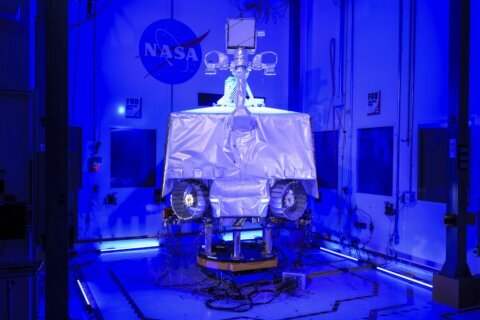NASA instruments captured the moment part of the sun appeared to break off from the giant star and get swept up in a polar vortex. But according to the scientist who drew attention to it, it’s not as dire as it sounds.
Tamitha Skov, a space weather physicist and research scientist at The Aerospace Corporation in Southern California, went viral for the news earlier this month when she shared imagery of the event.
“Talk about Polar Vortex!” she tweeted. “Material from a northern prominence just broke away from the main filament & is now circulating in a massive polar vortex around the north pole of our Star.”
Basically, a big piece of plasma broke away off the sun’s surface. And the polar vortex it was swept up in isn’t the same as a polar vortex we might experience here on Earth.
According to the National Weather Service, a polar vortex on our planet is a large low-pressure system of cold air that strengthens in the winter. On Earth, it happens “fairly regularly” and is known for sending surges of Arctic weather to nearby areas.
But Sara Housseal, space weather operations senior duty officer at the U.S. Air Force’s Space Weather Operations Center, says that on the sun, it’s an event that’s “far less understood or known.”
“While it may (or not) always be present, it’s not always seen,” she said, “so the filament that got caught in it allowed us to physically see it and study it.”
The break-off in question happened about midday on Feb. 2 and can be seen on the upper left portion of the sun. In a video later posted to her Patreon account, Skov further explained the significance of the event.
“Some of that material begins to break off of the main structure and start getting caught up in what looks to be a polar wind,” she said. “And as that stuff begins to get swept up in it, you can see it takes about 8 hours for that material to completely circumnavigate the pole at about 60 degrees.”
According to her preliminary calculations, Skov said that the polar wind was moving “insanely fast” – at about 60 miles a second.
Solar physicist Scott McIntosh, deputy director at the National Center for Atmospheric Research, told Space.com that plasma breaking off the sun’s surface like this has happened at the sun’s 55-degree latitude in previous solar cycles, which last 11 years.
Solar prominences, which are seen as the bright pieces of plasma coming off the sun’s surface and looping back down to anchor to it, are common. According to the University Corporation for Atmospheric Research, these events are “enormous” and can extend out for thousands of miles. They can also last for “several days or up to several months.”
However, McIntosh said, he’s never seen a prominence and vortex interact like this before.
“Once every solar cycle, it forms at the 55-degree latitude and it starts to march up to the solar poles,” he said. “It’s very curious. There is a big ‘why’ question around it. Why does it only move toward the pole one time and then disappears and then comes back, magically, three or four years later in exactly the same region?”
The finding could have “exciting” implications for the understanding of the solar system, Skov said, as other gas giant planets Saturn and Jupiter are also known for their intense polar winds.
“It turns out our sun has more in common with these gas giants than one might think,” she said. “…So although the sun still holds onto some of its mysteries, today, we might’ve gotten just one step closer.”
Skov told ABC Radio Melbourne that it was a “very rare observation” about the goings-on at the sun’s surface.
“This material allowed us to really observe the winds and how quickly things were moving,” she said. “…We really need to start learning more about how this big, magnetic activity engine – what we call the magnetic dynamo – how it works, because that’s really what generates space weather.”







